Highlights
- Discover tapas, wine, and historic monasteries in and around Barcelona
- Learn about Alhambra's history, flamenco, and traditional pottery in Granada
- Take a two-hour private tour of Madrid's Museo de Prado with a local expert
- Fly to Marrakesh to see its main square, Jemaa el-Fna, and wander its souks
- Enjoy the coastal vibes in Essaouira, Rabat, and Casablanca along the Atlantic
Brief Itinerary
| Day | Highlights | Overnight |
|---|---|---|
| Day 1 | Arrive in Barcelona (Spain), Tapas Culinary Experience | Barcelona |
| Day 2 | Private Tour of Barcelona & La Sagrada Família, Visit Park Güell | Barcelona |
| Day 3 | Day Trip to Montserrat & the Penedès Wine Region | Barcelona |
| Day 4 | Fly to Granada, Traditional Tile Decoration Workshop | Granada |
| Day 5 | Guided Tour of the Alhambra & Generalife Gardens, Flamenco Show | Granada |
| Day 6 | Transfer to Seville via Ronda & the White Villages | Seville |
| Day 7 | Guided Tour of Seville, Visit an Andalusian Olive Oil Estate | Seville |
| Day 8 | Day Trip to Córdoba | Seville |
| Day 9 | Train to Madrid, Guided Tour | Madrid |
| Day 10 | Guided Tour of the Museo del Prado | Madrid |
| Day 11 | Day Trip to Toledo | Madrid |
| Day 12 | Fly to Marrakesh (Morocco), Evening Street Food Tour | Marrakesh |
| Day 13 | Guided Tour of Marrakesh | Marrakesh |
| Day 14 | Day Trip to Essaouira | Marrakesh |
| Day 15 | Transfer to Rabat, Guided Tour | Rabat |
| Day 16 | Transfer to Fes via Meknes & the Roman Ruins of Volubilis | Fes |
| Day 17 | Explore Fes & the Medieval Medina | Fes |
| Day 18 | Day Trip to Chefchaouen | Fes |
| Day 19 | Transfer to Casablanca, Guided Tour of the Hassan II Mosque | Casablanca |
| Day 20 | Free Day in Casablanca | Casablanca |
| Day 21 | Depart Casablanca |
Detailed Itinerary
Day 1: Arrive in Barcelona (Spain), Tapas Culinary Experience

Welcome to Spain! Upon arrival in Barcelona, a driver will be waiting to take you to your hotel in the city center. Once you've had time to settle in your room, you can explore at your own pace—or take a siesta—before heading out for tonight's activity.
At the appointed time, meet your guide in the hotel lobby for an authentic tapas culinary experience that takes you through the city's typical neighborhoods. This is where you can see how the locals live, eat, and spend their evenings in Barcelona. Enjoy eating small bites from several shared plates at authentic restaurants and bars while your guide shares tips and insider knowledge about the city.
Day 2: Private Tour of Barcelona & La Sagrada Família, Visit Park Güell
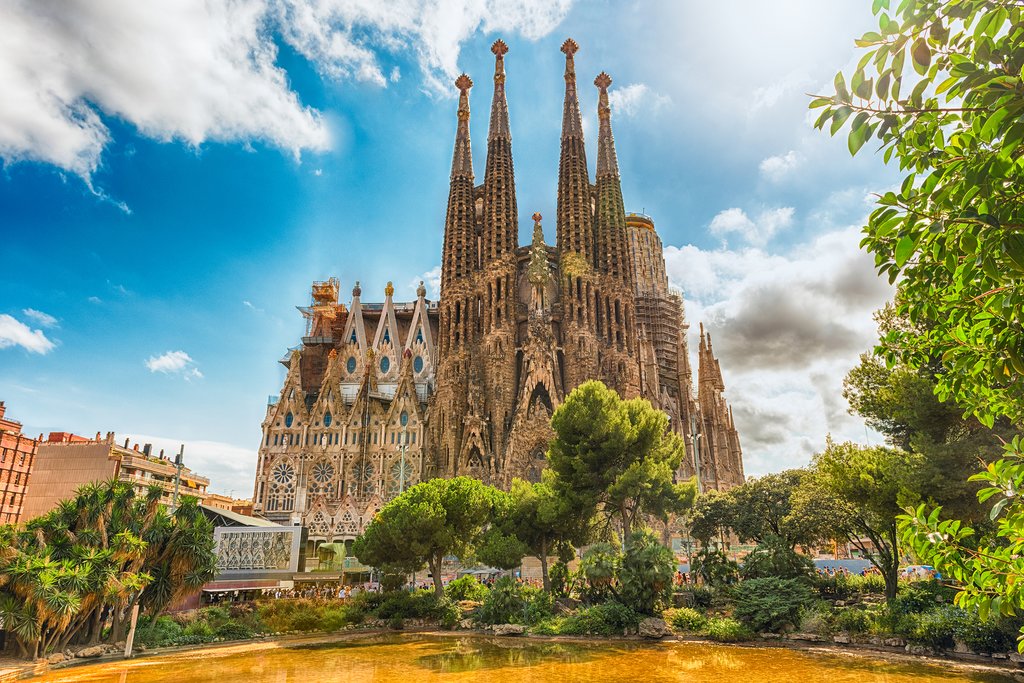
After breakfast at your hotel, you'll take a private guided walking tour of Barcelona, which includes its most significant monument, La Sagrada Família, a spectacular Roman Catholic church, and a UNESCO World Heritage Site designed by Catalan architect Antoni Gaudí. During this half-day excursion, you'll see some of the city's most emblematic spots and hidden corners while learning about Gaudí and his jaw-dropping masterpiece, which is still under construction.
Your guide will be on hand to answer all your questions, including where to go for lunch. Enjoy lunch at a tapas bar or restaurant before being left to enjoy the afternoon exploring Barcelona at your own pace. You won't want to miss a visit to Park Güell, located atop Carmel Hill in north Barcelona. This UNESCO World Heritage Site is a fine example of Gaudí's boundary-pushing modernist style. The park takes up 42 acres (17 ha), and you'll marvel at every building as you stroll the walkways and gardens. There are also incredible views at many points in the park that look over the city.Day 3: Day Trip to Montserrat & the Penedès Wine Region

This morning, meet your guide at Barcelona's Palau de la Musica and make the one-hour drive to Montserrat. Start by exploring the Santa Maria de Montserrat Benedictine Monastery, Catalonia's monastic center, to see the famous Black Virgin, a sculpture many believe was carved in Jerusalem in the early days of Christianity, located in the basilica. You'll also have time to visit the Museum of Montserrat, a treasure trove of archaeology, modern painting, and sculpture. There are many trails within this magnificent mountain setting where you can see spectacular views over the plains of Catalonia.
If you don't want to walk, take one of the mountain railway lines or the cable car to see splendid views of the area. After lunch, drive through scenic back roads into the Penedès winegrowing region, where you'll visit a renowned local winery for a tour of their vast cellars, followed by a cava wine-tasting session. See how the Spanish sparkling wine is produced, from the first pressing of the grapes to the second fermentation in the cellars. Then sample some of this precious nectar and the end of the tour. Afterward, return to your hotel.Day 4: Fly to Granada, Traditional Tile Decoration Workshop

Transfer from your hotel to the airport this morning and catch a short 1.5-hour flight to Granada. Upon arrival, you'll be driven by private transfer to your hotel. Once settled, you'll meet for a traditional tile painting workshop. Loza, or pottery from Fajalauza, is glazed and decorated clay, initially made in Granada's Albaicín neighborhood, with a pottery tradition dating back to 1517. It has remained invariable in style and is characterized by blue-gray or green with plant motifs and the prominence of pomegranates, birds, lacework, and heraldic motifs with double-faced eagles.
Day 5: Guided Tour of the Alhambra & Generalife Gardens, Flamenco Show

When the Moors ruled it, Granada was once the last bastion of Al-Andalus (Muslim Spain). You can see examples of this by visiting the Alhambra with a private guide. This imposing Muslim fortress was built atop a hill overlooking Granada and dates back to the ninth century. It was rebuilt in the 14th century by the Nasrid Dynasty and served as a Moorish palace until 1492. It's now a UNESCO World Heritage Site, and on a tour, you'll walk through its grand halls and stroll the Generalife Gardens, which are filled with colorful flowers and fountains and offer panoramic views of the city below.
In the evening, get ready for some flamenco dancing, the ultimate artistic expression of Andalusia. Granada is undoubtedly one of the cradles of flamenco in Spain, particularly the Sacromonte neighborhood. This Romani neighborhood is the epicenter of what the experts call the jondura, and it originates from the zambra, a flamenco dance and singing party. Between the 18th and 19th centuries, Romani waited at the door's caves to perform their flamenco show for travelers. Tonight, you'll head to Sacromonte and enjoy an authentic flamenco show in a natural cave.Day 6: Transfer to Seville via Ronda & the White Villages

Get ready for an incredible private road trip through Andalusia. After breakfast, your driver will pick you up for the three-hour journey to Seville. However, you'll break up the drive with a stop in Ronda, a quaint village with a dramatic perch. Travel west to National Natural Sierra Grazalema, a national park and UNESCO Biosphere Reserve. The landscapes here are wild, featuring towering limestone peaks, deep gorges, and storybook hamlets. You'll also drive around Grazalema, a postcard village inhabited since Roman times.
Next is a mountain road called Puerto de las Palomas, which features viewpoints at 3,795 feet (1,157 meters) in altitude. From here, you'll have dramatic views over the provinces of Cádiz, Málaga, and Seville. After marveling at the landscapes and allowing plenty of time for photos, you'll hop back in the car for the final leg of the journey to Seville. Upon arrival, check into your hotel.Day 7: Guided Visit of Seville, Visit an Andalusian Olive Oil Estate
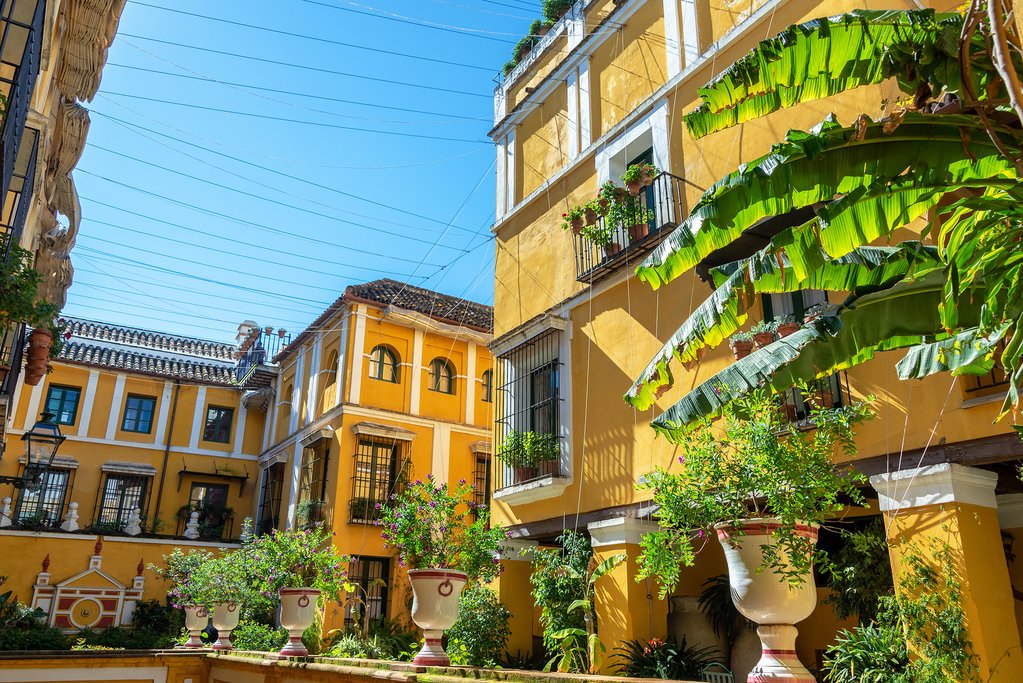
Get acquainted with Seville on a guided walking tour and learn about its 2,000-year history. With a local guide, you'll admire the Seville Cathedral, a 15th-century Roman-Catholic church. It's a UNESCO World Heritage Site, the largest Gothic church in the world, and an awe-inspiring testament to pious grandiosity. You'll also see La Giralda, the cathedral's looming bell tower. There's a noticeable stylistic difference between the two structures, as this 12th-century pillar was initially built as a minaret for the Great Mosque back when the Moors ruled Andalusia.
Walk to the orange tree-filled Santa Cruz neighborhood, known as the Jewish Quarter, with its narrow streets and quaint squares. It's a colorful and well-preserved part of the historic center, with many cafés and tapas bars—the perfect excuse to take a break and enjoy some small plates and local wine. Conclude your walk at the banks of the Guadalquivir River. You'll also visit the Alcazar, a majestic UNESCO-listed monument with palaces and gardens representing a harmonious synthesis between Christian and Muslim cultures.
Later, meet your driver in the hotel lobby and head to an Andalusian olive oil estate, where you'll witness the production process of olive oil, one of Spain's most famous exports. Discover the estate's history as you view the 16th-century olive-oil presses. You'll also visit the estate's working presses, which use modern methods to produce the olive oil they export today. View the gorgeous rolling hills carpeted in olive trees and vineyards. Finish with an olive oil tasting, allowing you to put your newfound knowledge to the test before returning to Seville.
Chat with a local specialist who can help organize your trip.
Day 8: Day Trip to Córdoba

Today you'll head to Seville's train station for the 40-minute journey northeast to Córdoba. This is another romantic city in the Andalusia region, filled with historic Mudéjar architecture. Upon arrival, meet your guide for a tour of the city's historical sights, including the breathtaking Mezquita, a pagan temple converted into the great mosque of the Ummayad caliphate. Later it was transformed into a Catholic church. You'll also meander around the winding streets of the Jewish Quarter, and within this historic neighborhood is the Córdoba Synagogue, which dates to 1315.
Visit the Alcázar de los Reyes, a palace built in the 14th century. The terraced gardens, fish ponds, flower beds, and orange trees make great photo opportunities. After your guided visit, you will have some time to explore the city on your own before your return to Seville.Day 9: Train to Madrid, Guided Tour
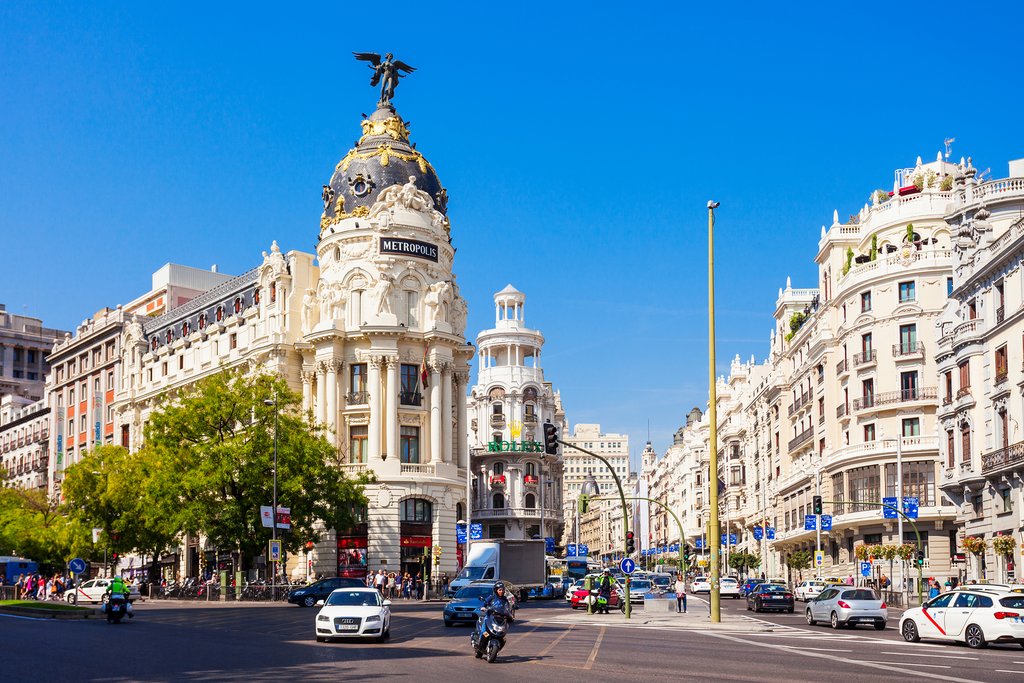
Be prepared for a change of pace as you leave Andalusia by train and head to Madrid. Once you've checked in at your hotel, meet your guide to see the Spanish capital's loveliest and most emblematic places: the Habsburg district. This is the oldest part of the city, known in Spanish as El Madrid de Los Austrias.
You'll see striking buildings along the way, such as the Royal Palace, Palacio Real de Madrid, Almudena Cathedral, the main square of Plaza Mayor, and some hidden and overlooked corners and mysteries of Madrid's old town. Your guide will also recommend an authentic place to stop for a drink. Afterward, with the fresh insights you have gained into city history and culture, continue exploring Madrid at your own pace.Day 10: Guided Tour of the Museo del Prado

Madrid is also home to some can't-miss museums like the Museo del Prado, which boasts one of the finest collections of European art spanning the 12th through the 20th century. At the appointed time, you'll meet your private guide for a two-hour tour of the museum, who will point out works from featured artists like Goya, Bosch, El Greco, Titian, and Velázquez, among others.
Day 11: Day Trip to Toledo
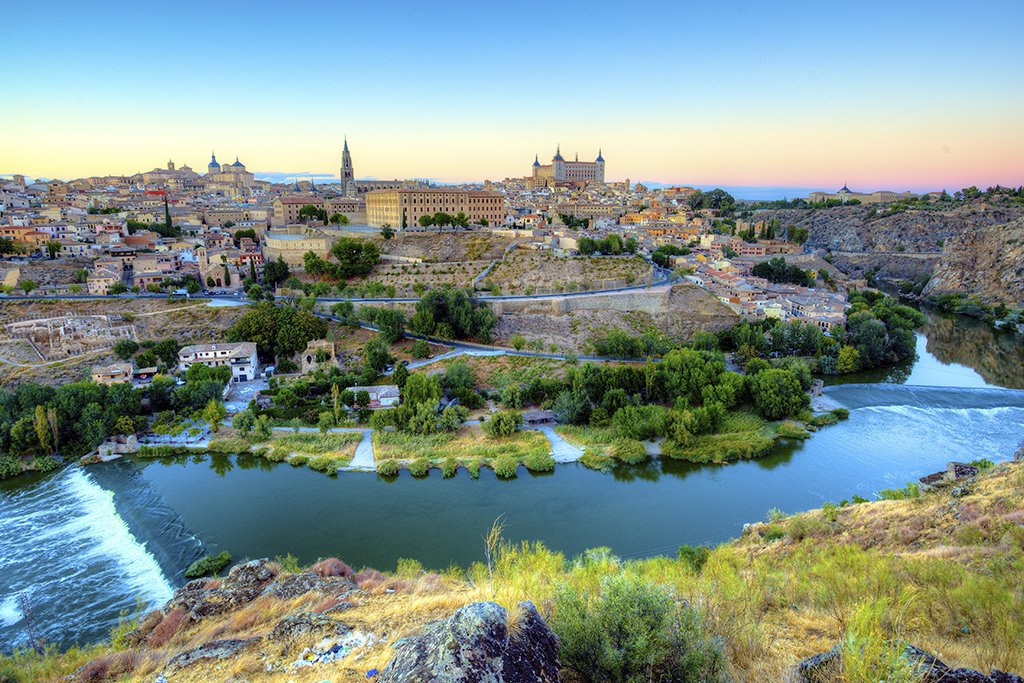
Rise and shine this morning as you head to Madrid's train station for a 30-minute ride south to Toledo. In the Middle Ages, Toledo was known as the "City of Three Cultures," where Christian, Muslim, and Jewish communities peacefully coexisted. See remnants in the old Arab, Muslim, and Christian monuments that still stand. These include the 15th-century Monastery of San Juan de los Reyes, the former Roman palace Alcázar de Toledo, and the Moorish Synagogue of Santa María la Blanca, which dates to the 12th century.
Accompanied by your expert guide, you'll visit these historic landmarks and others, including the grand 13th-century Toledo Cathedral and the 12th-century Church of Santo Tomé. Tour the ancient streets of an incredible city that could aptly be described as an open-air museum. You'll return to Madrid by train.Day 12: Fly to Marrakesh (Morocco), Evening Street Food Tour

Brace yourself for a massive change of scenery today! At the appointed time, a driver will take you to the airport for your flight to Marrakesh. Upon arrival, a private driver will pick you up and take you to your hotel in the town center. Relax a bit before discovering the city at night, and be sure to have an empty stomach for the immersive gastronomic experience that awaits you.
This evening's food tour takes you well beyond Jemma el Fna, the main square of Marrakesh. Your expert guide will lead you to experience parts of Moroccan food culture hidden from view. Dive deep into the city's passages and back alleys of the medina (old town) with plenty of stops to taste authentic Morrocan dishes. You'll also visit the Souk Mama, where you'll get a crash course in preparing a Moroccan staple.Day 13: Guided Tour of Marrakesh

Your guide will meet you at the hotel this morning for a half-day guided visit in Marrakesh. Visit historical sites, such as the Koutoubia Mosque and the Saadien Tombs. You'll enter through a narrow passage and discover a small garden, graves, and three main pavilions. Next is El Badi Palace, built in the early 17th century, where you can appreciate the extensive courtyard and sunken gardens. The morning is focused on the city's culture, sidewinding your way through the different artisan areas within the souqs.
Afterward, you'll have time to explore the city on your own. See Bahia Palace, built in the 19th century, which was the largest and most luxurious palace of its day. Explore the courtyard and gardens while appreciating the intricate woodwork and painted ceilings. Not far from the hustle and bustle of the medina, you can wander through the lush Majorelle Gardens, filled with subtropical plants, bamboo, lilies, and palms. It's a perfect place to escape the afternoon heat and noise for a relaxing experience.
Day 14: Day Trip to Essaouira

Take a trip to the coast from Marrakesh to ancient Essaouira, which was formerly known as Mogador. A driver will pick you up at your hotel and drive you 118 miles (191 km) to the 18th-century town on the coast surrounded by medieval battlements.
When you arrive, you'll tour Essaouira's UNESCO-listed medina, made up of whitewashed buildings with blue shutters and colonnades. You can also explore its busy fishing harbor, where you'll find fresh seafood, and stroll along the Skala de la Kasbah and the beach. Your driver will return you to Marrakesh in the early evening.Day 15: Transfer to Rabat, Guided Tour

This morning, a driver will meet you in the hotel lobby and take you on the 3.5-hour journey to Rabat. You'll check into your hotel and head back out to explore Morocco's capital with a local guide. See the Royal Palace of Rabat and the medieval fortification of the Chellah Necropolis, where you can wander the Roman and Islamic ruins. Stroll through the medina to find the Hassan Tower and Mausoleum of Mohamed V. This abandoned 12th-century project features the minaret of an incomplete mosque and some 200 columns.
Stop at the souks (markets), where you can peruse local crafts and goods, such as rugs, spices, slippers, jewelry, leather, and more. Although bartering is part of the fun, your guide will be happy to help. Next, visit the 20th-century Andalusian Gardens and enjoy the serene space away from the crowds. The lush terraces are filled with walking paths, exotic plants, flowers, and fruit trees reminiscent of the famous gardens in the Alhambra in southern Spain. It's the ideal place to relax and escape the afternoon heat.
Finally, you'll reach Rabat's gate to the old city center, the Kasbah des Oudaïas. Home to the city's oldest mosque and a handicrafts museum called Musée des Oudaïas, spend some time admiring the white and blue architecture while learning about traditional regional crafts.Day 16: Transfer to Fes via Meknes & the Roman Ruins of Volubilis

It's time to say goodbye to Rabat and travel to Fes. Along the way, you'll see one of Morocco's famous imperial cities and visit the remains of the Kingdom of Mauretania's former capital. Your driver will collect you at your hotel, and the first stop will be the Roman ruins of Volubilis. Along with your guide, explore the remains of this 2000-year-old complex containing Morocco's best-preserved Roman ruins. Wander through the massive collection of large merchant homes with visible heating systems, temples, and many colorful mosaics. Just down the road, tour Moulay Idriss, one of Morocco's holiest cities.
Next, transfer to Meknes to explore the medina and visit some monumental city gates and ornamental decorations highlighting Spanish-Moorish architecture. Walk along the city walls and stop at the Mausoleum of Moulay Ismail, founder of the Alaouite Dynasty and sultan when Meknes was its capital city. To end your visit, peruse the Museum of Moroccan Art and view various regional handicrafts. Later in the afternoon, head to Fes, where you'll check into your hotel and have a free evening.Day 17: Explore Fes & the Medieval Medina

After breakfast, you'll learn about Fes, the oldest of Morocco's imperial cities and perhaps the most interesting and exciting to explore, accompanied by a local private guide. The UNESCO-listed medina in Fes is the most complete in the Arab world. Because the city never experienced much colonial work, it feels like stepping back through time hundreds of years.
The charming medina will likely draw most of your time and focus. The roads are much narrower, windier, and steeper than those of other imperial cities, making it almost impossible not to get lost at least a few times. This is part of the fun: Keep walking until the flow of people increases, and you find yourself on one of the main streets. Shop at the souks for various spices, vegetables, leather goods, ceramics, pewter, shoes, scarves, medicines, and more. Many are concentrated together, and you're bound to see artisans at work in their small shops.You will also visit the Karaouine Mosque, the city's most magnificent and historic religious attraction. Then, after lunch, see the Merenid Tombs on the valley's rim. Both offer fantastic views of this dynamic city with timeless roots.
Day 18: Day Trip to Chefchaouen

Discover the streets and monuments of Morocco's famed Blue City, Chefchaouen, on this day trip from Fes. Its name translates to "two horns," referencing the town's two mountain peaks. Beautifully perched beneath the Rif Mountains, Chefchaouen is one of the prettiest towns in Morocco, an artsy, blue-washed mountain village that feels like its own world. It was founded in 1471 as a stronghold in the fight against the Portuguese, and it has eight mosques and several zaouias.
The city's old medina is a delight of Moroccan and Andalusian influence, with red-tiled roofs, bright-blue buildings, and narrow lanes converging on the busy Plaza Uta el-Hammam. Take time to peruse the nearby souks and enjoy a meal at one of the great restaurants. You'll be picked up and transferred back to Fes in the afternoon.Day 19: Transfer to Casablanca, Guided Tour of the Hassan II Mosque
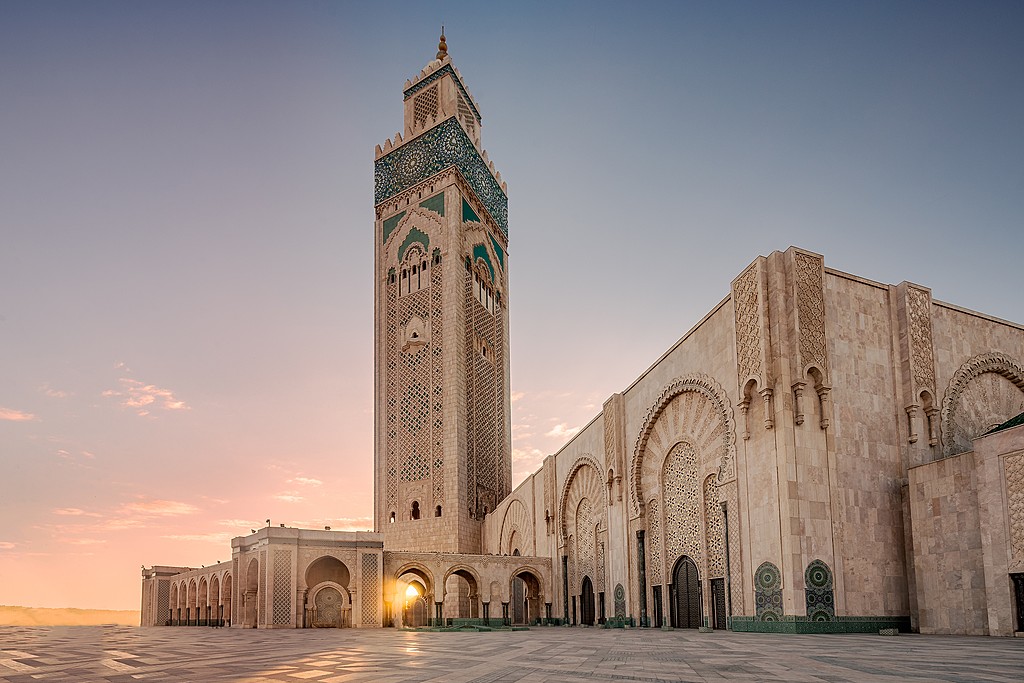
Today, sit back and enjoy a comfortable private transfer from Fes to your hotel in Casablanca, which takes about four hours. After settling in, a private guide will lead you through the massive Hassan II Mosque, the largest mosque in Morocco, which sits on the edge of the Atlantic Ocean. Its large complex includes a museum, baths, Koranic school, a library, and a prayer room supported by 78 granite and marble pillars. As the second-largest mosque globally, the prayer room holds 25,000 people, and the outside courtyard can accommodate an additional 80,000 worshippers.
The mosque's 650-foot (200 m) minaret is jaw-dropping. As you walk up to the mosque, admire and photograph the impressive exterior and surrounding area before entering. With your guide, admire the ornate design with beautiful green hues and mosaic tiles, as well as wood, marble, and carved stone with arched and ornamented ceilings. At night, the mosque glows orange, illuminated by lights that reflect on the ocean's waves. Artisans from across Morocco contributed to this superb architectural masterpiece.
Day 20: Free Day in Casablanca

Spend today exploring Casablanca at your own pace. Morocco's modern commercial capital has few tourist sights compared to the historic imperial cities of Fes and Marrakesh, so you can take your time. Begin in the old medina, which is much newer than the medinas of Fes and Marrakesh. Wander through its cobbled streets, perhaps picking up fresh fruit or souvenirs. Then head to the Habbous, Casablanca's new medina, built in the early 20th century by the French.
In the Habbous, keep an eye out for Art Deco architecture and stop in some shops selling spices, crafts, and traditional garb, like djellabas (traditional Moroccan robes). Afterward, head down to the beachside promenade along the Boulevard de la Corniche, sometimes referred to as Morocco's Miami. Here, you can pause for a meal in one of the high-end restaurants lining the waterfront or gaze out over the Atlantic from the top of the El Hank Lighthouse. In the evening, follow in the footsteps of Ingrid Bergman and Humphrey Bogart by visiting Rick's Café, which recreates the famous scene in the legendary film Casablanca.
Day 21: Depart Casablanca

The day has come to say goodbye to Morocco! At the appointed hour, a private driver will pick you up from your hotel and transport you to Casablanca's airport. Have a safe and comfortable flight home or to your next destination!
More Great Morocco Itineraries
Looking for more inspiration for your trip to Morocco? Check out these other Morocco itineraries, explore more ways to spend three weeks in Spain and Morocco, or discover the best time to visit Morocco.


